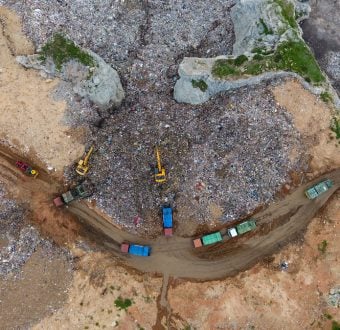Our planet can no longer tolerate a culture of throw-away plastics. Single-use plastics are filling up our landfills, choking our rivers, and contaminating our oceans. For far too long, corporations have put the onus on all of us to deal with their own failed design problem. We have been told that the individual should simply recycle away the billions of tons of plastics corporations produce and that it will make the difference needed to sustain our planet.
We have been told a lie.
Over 90% of plastics are not recycled. By the year 2050, some estimate that there will be more plastics than fish in the world’s oceans if we do not change course. Recycling alone is simply never going to solve this problem. It is up to all of us to demand better — to tell these corporate giants that we will no longer tolerate the plastics they force upon us. It’s time for us to reject the old corporate story that a throw-away lifestyle makes us happy.
Nothing that is used for a few minutes should end up polluting our oceans for a lifetime.
Single-use plastics, including plastic packaging, bags, and styrofoam make up 26% of global plastics production and are the bulk of the plastic pollution problem in oceans, waterways, and communities. An estimated 150 million metric tons of plastic have already entered our seas, where it will take centuries to break down. With plastic production set to double in the next 20 years, much of this for plastic packaging, the threats to ocean biodiversity and seafood supply chains are increasing.The UN describes this as a potential “toxic time-bomb.”
We can no longer afford corporations’ throwaway plastic business models. It’s time for a fundamental shift in the way that corporations bring products to people.
This is why Greenpeace and many others are emphasizing the need to reduce plastic production and break free from plastic rather than simply increase recycled content. To illustrate this point, I am documenting all the single-use plastic pushed on me on a daily basis, and I invite you to join me. Check out what I’ve found so far:

Day 1: Trader Joe’s, why? I love your ginger turmeric tea, but these single-use plastic tea bag wrappers are just ridiculous. Bags inside a box are not necessary.

Day 2: Red Blossom, your blueberry game is strong. Love the taste, antioxidants are hella on point. But while the berries are good for human health, these plastic containers are not great for the health of the planet.

Day 3: Order a coffee “for here,” and you get a cup “to go.” What’s the deal, Port City Java? You realize #6 plastics are super duper hard to even recycle AND leak styrene, a toxin for the brain and nervous system? Mugs are great, where the mugs at?

Day 4: Jason! Come on, dude! Your deodorant makes people smell like flowers, but what is the point of this little plastic thing? Is there even a word for this? What IS it and WHY does it exist?

Day 5: GUM! Listen up! Hey hey, ho ho, throwaway floss has got to go! Dental hygiene is important, but look at this single-use plastic to floss ratio. Can we fix that?

Day 6: Pepperidge Farm, your cookies are life. But these single-use plastic wrappings are quite literally death for the marine life that will suffocate on them in the oceans.

Day 7: Hershey, you make some damn delicious peppermint patties. Highlight of my late afternoon snack. But you break my heart with these individually wrapped single-use packages.

Day 8: Maybelline! This is a whole lot of throwaway plastic for such a tiny little eyeliner pencil. Why?

In just one week, I’ve been carrying around enough of my own personal plastic waste to fill up this vase. The worst part? Only one of the items pictured above is recyclable, and as you now know, that doesn’t guarantee it will actually get recycled. The blueberry container is a #1 plastic, which can only be “downcycled” – turned into progressively lower quality products until it can no longer be recycled and becomes landfill waste.

Day 9: Ziploc. Duh duh duhhhhhh. We are all guilty of using these once in a while. Brought into the world by none other than Dow Chemical Company – which also brought Cancer Alley to Louisiana – Ziploc bags are now produced by S. C. Johnson & Son. I’m calling you out. Do better.

Day 10: The internet is debating what these are called, so I’ll go with my favorite: the plastic fastening dongle! Shout out to the anonymous user in this debate who called for outlawing these “because they are so small that I am sure this is what [takes] up half of the plastic gyres in the ocean.” YES!

Day 11: Yep. Even the tags inside your clothing are plastic. Polyester is a plastic product, and you know what that means? Your dirty laundry is polluting the ocean, too.

Day 12: I was enjoying a lovely time at Matchbox, and every person at my table was served a glass of water with a plastic straw that nobody asked for. According to this plastic straw manufacturer, a box of 5,000 straws costs $4.40, or $0.082 per straw. This price does not reflect the externalized cost that disposable plastic straws pose to our oceans and marine wildlife. It’s time for restaurants to ditch straws and follow this example. (Note: Straws do make life easier for some folks. Disability rights organizations like this one are calling for changes on straws, too.)

Day 13: Apparently slippers need to be sold attached to a giant plastic board. Dearfoams, your tag line is “make yourself comfortable.” I’ll be much more comfortable without so much single-use plastic.

Day 14: As if getting five bills mailed to you the same day isn’t bad enough, EVERY SINGLE ENVELOPE contained single-use plastic. Listen, BGTaxForms, I know you have work to do – but can you do it without dumping plastic on all of us?

Day 15: GT’s Kombucha. With these glass bottles, you’re so close to the plastic-free dream! Ditch these plastic tops and we can be BFFs.

Day 16: Scott brand, you can boast that your TP tubes use 100% recycled material, but all I hear is the loud crinkle of this unrecyclable single-use plastic packaging.

Day 17: Lean Cuisine. Considering that your parent company, Nestlé, was found to be 2017’s dirtiest corporate plastic polluter worldwide, I guess this isn’t too surprising – and it’s not okay.

Day 18: Wrigley’s, as the largest manufacturer and marketer of chewing gum in the world, you have a responsibility to lead the way in your industry. Gum-chewers unite for a plastic-free future!

Day 19: Colgate-Palmolive. It’s great to remind people that #EveryDropCounts, but don’t forget that this plastic packaging will likely end up in our waterways. You can certainly save water by turning off the faucet when you brush, but you can save even more water by breaking free from plastic!

Day 20: CVS Health. Does my menstrual cycle really have to contribute to ocean plastic pollution with these single-use pad wraps? I’ve had enough, period. (Wink wink!)

Day 21: Dixie. There are so many great alternatives out there, from bamboo cutlery to edible spoons! Get on board the cool kids train.

Day 22: Target, I appreciate that your new line of women’s clothing “A New Day” abstains from plastic fastening dongles (#TBT Day 10!) but then you throw these nameless plastic things into the mix and I have to call you out on it. Womp womp.

Day 23: UGHHHH! Coffee stirrers are my #1 plastic pet peeve. The epitome of single-use pointless plastic, stirrers are not recyclable and get tossed straight into the trash after being used for less than 5 seconds. With too many brands and coffee shop chains to name here, I’m calling out the existence of these tiny devils. Next time you are at your favorite coffee shop, ask the manager whether they’ve ever seen where plastic straws and stirrers end up. Give them a clue: Stuck inside the noses of sea turtles.

Day 24: Little Brownies Bakers, it breaks my heart to say this, but you too need to break free from plastic. Thin Mints and Samoa cookies are good for the soul, but this single-use plastic packaging is terrible for the oceans. Girl Scouts deserve better!

Day 25: Heinz, as one of over 200 Kraft Heinz Company brands, you are not the only guilty unrecyclable single-use plastic mustard packet. Kraft Heinz is the third-largest food and beverage company in North America and the fifth-largest food and beverage company in the world. Question, how much plastic do y’all toss out per day? Just wondering.

Day 26: Solo Cup Company, this is a major public health issue. Styrofoam can leach styrene, a nervous system toxin that is also present in second-hand cigarette smoke and car exhaust fumes. Styrene leaching increases when the liquid is hot – meaning you are facilitating the addition of a possible carcinogen into your costumers’ coffee. NOT OKAY!

Day 27: Hey Novolex, your Hilex brand produce bags are missing something… “WARNING: To avoid danger of irreversible ocean plastic pollution, don’t make single-use bags out of disposable plastic that lasts forever.”

Day 28: Harris Teeter. I came for potatoes, not plastic. Please, just the potatoes. Thanks.

Day 29. Gruma Corporation, your subsidiary brand Mission Foods has a plastic problem. Don’t ruin corn tortillas for us. Break free from plastic!

Day 30: S.C. Johnson & Son, you have a knack for this disposable plastic thing. Saran wrap and Ziploc bags are familiar household items that we can no longer keep using once and tossing out. I challenge you to devise a more responsible business model. Our oceans, coasts, and communities depend on it.
But there is good news! A few supporters have joined in the challenge, and companies are already responding – including GT’s Kombucha! Check it out:


YAY! And there’s more!


If you’re curious about what your personal plastic waste looks like, start to notice and snap pictures as you go. Ask yourself:
- Is this recyclable? How can I be sure? (Note: Check the little number inside the recycling triangle and find out!)
- How are the companies behind this production system benefiting by shifting the burden and cost onto me?
- DON’T FEEL GUILTY. See #2. This is a problem of the disposable plastic system that together we can change. Don’t take it personally. Do react.
Greenpeace needs your help demanding corporate accountability for the plastic problem. You’ve seen what my personal plastic waste looks like, and you joined me in this live blog throughout the month of March. Now it’s your turn! As we gear up for big things on Earth Day, it’s time for all of us to demand better from corporate plastic producers who are pushing their waste problem onto individuals like us. If you are up for the challenge and want to join me, you can share your name/photo/brand/manufacturer in one of 4 ways:
-
- Facebook: Tag @GreenpeaceUSA and the brand responsible!
- Twitter: Use hashtags #PointlessPlastic, #RidiculousPackaging, #BreakFreeFromPlastic, and the brand responsible!
- Instagram: Tag @greenpeaceusa and the brand responsible!
- Email: [email protected]
Tell me your story! We are all affected by single-use plastic pollution. Let’s all drive forward solutions together!


